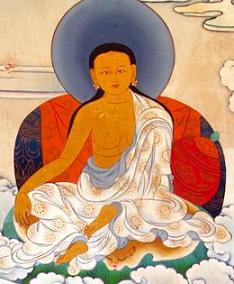Kagyü: Difference between revisions
No edit summary |
|||
| Line 13: | Line 13: | ||
====Eight Pagdru Kagyü Sub-schools==== | ====Eight Pagdru Kagyü Sub-schools==== | ||
{{:Eight Pagdru Kagyü Sub-schools}} | |||
Today, only the first three of these eight Pagdru Kagyü sub-schools remain; these three are also the closest to the [[Nyingma]] school, with which sharing a large number of transmissions. | Today, only the first three of these eight Pagdru Kagyü sub-schools remain; these three are also the closest to the [[Nyingma]] school, with which sharing a large number of transmissions. | ||
Revision as of 17:07, 24 June 2009

Kagyü (Wyl. bka' brgyud) — one of the four main traditions of Tibetan Buddhism. The most important source of the Kagyü lineage (which literally means 'Lineage of the Oral Tradition') is traced back to the great Indian yogin Tilopa (988-1069) and one of his main disciples Naropa (1016-1100?). This lineage of teachings and practice was brought to Tibet, translated, and further spread by Marpa Lotsawa (1012-1097), who in turn empowered one of his main disciples, Milarepa (1040-1123)—considered to be the founder of the Kagyüpa school, called Drupgyü (Wyl. sgrub brgyud) at that time—with the continuation of the lineage.
Milarepa's main disciple, Gampopa, aka Dakpo Lharjé (1079-1173), brought together the Drupgyü and Kadampa lineages, thus founding the Dakpo Kagyü school. This lineage was later subdivided into four schools by his four main disciples.
Sub-schools
Four Major Schools of the Dakpo Kagyü
- Karma Kagyü, also known as Kamtsang Kagyü, founded by Düsum Khyenpa (1110-1193), later designated the first Karmapa
- Barom Kagyü, founded by Barompa Darma Wangchug (1127-1199)
- Tsalpa Kagyü, founded by Zangyu Dragpa Darma Drag (Zhang Rinpoche) (1123-1194)
- Pagdru Kagyü, founded by Phagmodrupa Dorje Gyalpo (1110-1170).
The Pagdru Kagyü school later splintered into eight sub-schools, which were founded by his eight main disciples, as follows:
Eight Pagdru Kagyü Sub-schools
- Drikung Kagyü, founded by Drikung Kyobpa Jikten Sumgön (1143-1217); it included the Lhapa sect, builders of the earliest dzongs in Bhutan, later eclipsed by the Drukpa.
- Drukpa Kagyü, founded by Lingje Repa Pema Dorje (1128-1188)
- Taklung Kagyü, founded by Taklung Thangpa Tashi Pal (1142-1210)
- Martsang Kagyü, founded by Marpa Drubthob Sherab Sengé, aka Chöjé Marpa (1135-1203)
- Shugseb Kagyü, founded by Kyer Gompa Chökyi Sengé (1144-1204)
- Trophu Kagyü, founded by Drogön Gyalsa (1118-1195) and his brother Kunden Repa (1148-1217)
- Yamzang Kagyü, founded by Kelden Yeshé Sangyé (d.1207)
- Yelpa Kagyü, founded by Yelphukpa aka Yelpa Yeshe Tsek (1134-1194)
Today, only the first three of these eight Pagdru Kagyü sub-schools remain; these three are also the closest to the Nyingma school, with which sharing a large number of transmissions.
Note: the Shangpa Kagyü school, although very similar to the Dakpo Kagyü school, is different in its Indian origins and practices. However, during the nineteenth century, these two lineages merged into one: the Dashang Kagyü lineage.
Further Reading
- E. Gene Smith, 'Golden Rosaries of the Bka' brgyud Schools' in Among Tibetan Texts, Boston: Wisdom Publications, 2001